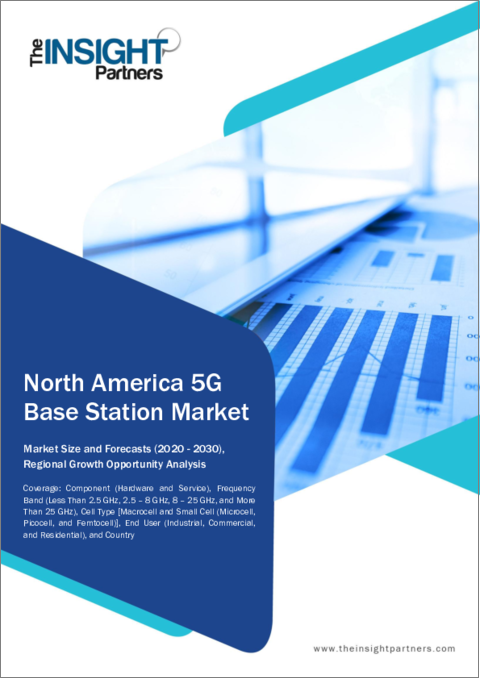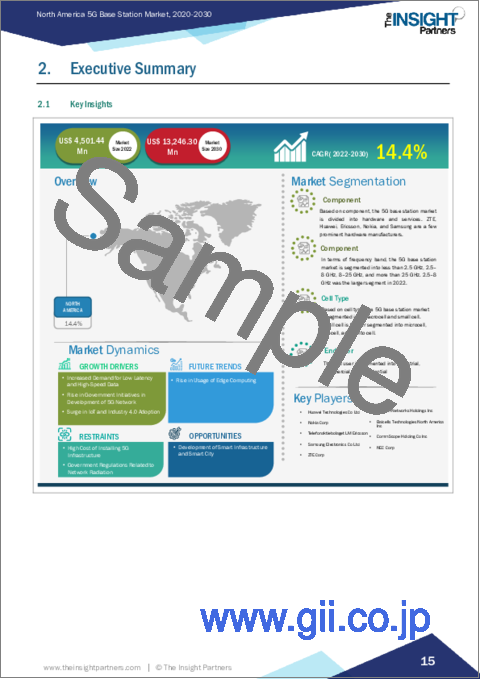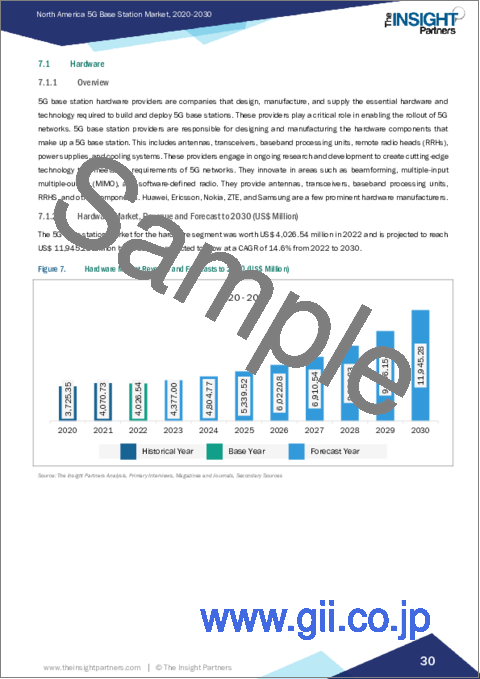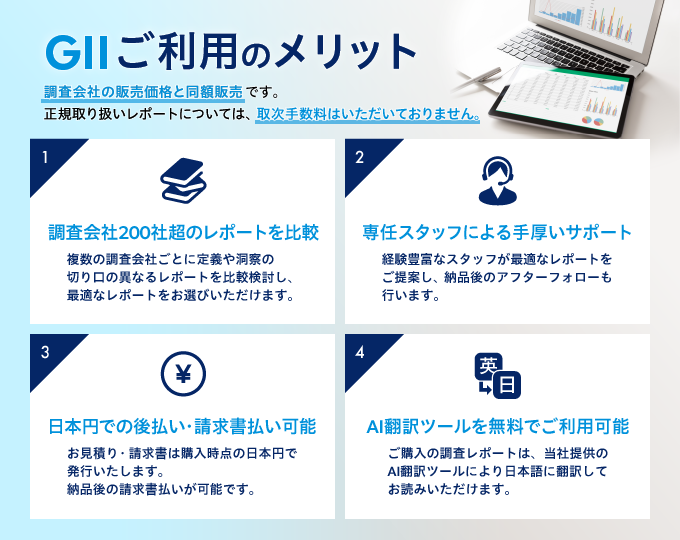|
|
市場調査レポート
商品コード
1533092
北米の5G基地局市場予測(~2030年):地域別分析 - コンポーネント別、周波数帯域別、セルタイプ別、エンドユーザー別North America 5G Base Station Market Forecast to 2030 - Regional Analysis - by Component, Frequency Band, Cell Type, and End User |
||||||
|
|||||||
| 北米の5G基地局市場予測(~2030年):地域別分析 - コンポーネント別、周波数帯域別、セルタイプ別、エンドユーザー別 |
|
出版日: 2024年06月04日
発行: The Insight Partners
ページ情報: 英文 104 Pages
納期: 即納可能
|
全表示
- 概要
- 図表
- 目次
北米の5G基地局の市場規模は、2022年に45億144万米ドルとなり、2030年には132億4,630万米ドルに達すると予測され、2022年から2030年までのCAGRは14.4%と推定されます。
低遅延・高速データへの需要の高まりが北米の5G基地局市場を後押し
低遅延の5Gネットワークは、ほぼ瞬時の応答が求められるサービスに新たな可能性をもたらします。こうしたサービスには、遠隔医療、拡張現実ヘッドセット、効率的な小隊への連結をサポートする自律走行車間の通信などが含まれます。遅延が少ないということは、信号の送信と受信の間の時間を短縮できることを意味します。5Gネットワークにより、ネットワーク範囲は少なくとも10ミリ秒以下、最良のケースでは約1ミリ秒の遅延となり、データはリアルタイムで転送されることになります。5Gベースのモバイル・ネットワークの進歩は低遅延を実現し、バーチャル・リアリティ体験、多人数参加型モバイル・ゲーム、工場用ロボット、迅速な応答が強い基準とされる自動運転車用途など、まったく新しい可能性への道を開きます。自動運転車に焦点を当てると、既存のセルラーネットワークはすでに、ビジネス要件に対応するさまざまなツールを提供しています。C-V2Xとその5G V2Xへの進化は、自動車業界と5Gに移行する他の業界との間の相乗効果を促進します。その極めて高いスループット、低遅延、強化された信頼性により、自動車はリッチなリアルタイム・データを共有できるようになり、自律走行やコネクテッド・ドライブをサポートします。例えば、LTE Cat-MとNarrow Internet of Things(NB-IoT)は、優れた低消費電力センサー通信技術です。複雑な車両操縦、例えば減速、車線変更、ルート変更、加速などを可能にするための個々の行動を決定し、推奨するためには、車両が運転意図に関する情報をリアルタイムで受信し、共有できなければなりません。この低遅延の要求は、最適化されたエンドツーエンドのV2X(Vehicle-to-Everything)接続を提供する全体的な5Gシステムアーキテクチャの開発によって満たすことができます。クラウドベースのサービス、ビッグデータ分析、モノのインターネット(IoT)の利用の増加に伴い、高速データ伝送と低遅延に対する需要が高まっています。リアルタイムのインタラクションの必要性や、さまざまな分野でのデータ集約型アプリケーションの利用増加により、低遅延で高速なデータに対する需要が高まっています。5G基地局は、高速、低遅延、高信頼性の接続に必要なインフラを提供することで、こうした需要に応えるために不可欠であり、進化する通信環境の重要な構成要素となっています。したがって、低遅延と高速データに対する需要の増加が5G基地局市場を牽引しています。
北米の5G基地局市場概要
北米の消費者は、スマートフォン、タブレット、IoTガジェットなど、5G対応デバイスの採用を増やしています。その結果、これらのデバイスを高速データと低遅延でサポートする5Gインフラに対するニーズが高まっています。北米の通信事業者は、最高の5Gサービスを提供するために熾烈な競争を繰り広げています。この競争は、より良いカバレッジとより速い速度を提供するために、より多くの5G基地局の展開を推進しています。例えば、エリクソンは2023年10月、5Gスタンドアロン・ネットワークの機能を強化し、差別化された接続性を備えたプレミアム・サービスを実現するための新しいソフトウェア・ツールキットを発表しました。このツールキットは、通信サービス・プロバイダー(CSP)が使用事例に応じて高スループット、高信頼性、低遅延のパフォーマンス・レベルを実現できるようにすることを目的としています。これらの使用事例には、遅延のないモバイルクラウドゲーム、ビデオ会議、ライブ放送、遠隔操作の機械・車両、公共安全サービス、将来のXRなどが含まれます。また、2023年8月、イーストリンクはノキアと提携し、カナダ全土の5Gネットワークを強化しました。この提携の下、イーストリンクは5G無線アクセスネットワーク(RAN)技術を含むノキアのAirScaleポートフォリオを利用してモバイルネットワークを近代化し、高速通信、比類のないパフォーマンス、ネットワーク容量の拡大を実現します。
同様に、AT&Tは2022年12月、5Gネットワーク・インフラをメキシコ全土の25都市に拡大しました。AT&T Mexicoは全国18都市で5Gサービスを提供しています。同事業者の5Gサービスは、メキシコシティ、グアダラハラ、モンテレイ、ティフアナ、メヒカリ、シウダー・フアレス、マサトラン、シウダー・オブレゴン、ナボホア、グアサベ、エンセナダ、プエルト・ペナスコ・グアムチル、クリアカン、サルティージョ、トレオン、モレリアで活発に行われています。5G基地局の需要が伸び続けるなか、通信事業者、インフラ・プロバイダー、テクノロジー企業は、消費者、企業、さまざまな業界の要件を満たすため、北米で5Gインフラの拡張とアップグレードに投資しています。したがって、上記の事例は、5G基地局市場が大きく成長していることを示しています。
北米の5G基地局市場の収益と2030年までの予測(金額)
北米の5G基地局市場セグメンテーション
北米の5G基地局市場は、コンポーネント、周波数帯域、セルタイプ、エンドユーザー、国に分類されます。
コンポーネント別では、北米の5G基地局市場はハードウェアとサービスに二分されます。2022年の市場シェアで大きかったのはハードウェアセグメントです。
周波数帯域では、北米の5G基地局市場は2.5GHz未満、2.5~8GHz、8~25GHz、25GHz超に区分されます。2022年の市場シェアは2.5~8GHzが最も大きくなりました。
セルタイプ別に見ると、北米の5G基地局市場はマクロセルとスモールセルに二分されます。2022年の市場シェアはスモールセルセグメントが大きいです。さらに、小型セルセグメントはマイクロセル、ピコセル、フェムトセルにサブセグメント化されます。
エンドユーザー別では、北米の5G基地局市場は産業、商業、住宅に区分されます。2022年には商業セグメントが最大の市場シェアを占めています。
国別では、北米の5G基地局市場は米国、カナダ、メキシコに区分されます。2022年の北米の5G基地局市場シェアは米国が独占しました。
Airspan Networks Holdings Inc、Baicells Technologies North America Inc、CommScope Holding Co Inc、Huawei Technologies Co Ltd、NEC Corp、Nokia Corp、Samsung Electronics Co Ltd、Telefonaktiebolaget LM Ericsson、ZTE Corpなどが北米の5G基地局市場で事業を展開する大手企業です。
目次
第1章 イントロダクション
第2章 エグゼクティブサマリー
- 主要洞察
- 市場の魅力
第3章 調査手法
- 調査範囲
- 2次調査
- 1次調査
第4章 北米の5G基地局市場情勢
- 概要
- 北米のPEST分析
- エコシステム分析
- バリューチェーンのベンダー一覧
第5章 北米の5G基地局市場:主要市場力学
- 北米の5G基地局市場:主要市場力学
- 市場促進要因
- 低遅延・高速データへの需要の高まり
- 5Gネットワーク開発における政府のイニシアチブの高まり
- IoTとインダストリー4.0の採用急増
- 市場抑制要因
- 5Gインフラの導入コストの高さ
- ネットワーク放射線に関する政府規制
- 市場機会
- スマートインフラとスマートシティの発展
- 今後の動向
- エッジコンピューティングの利用増加
- 促進要因と抑制要因の影響
第6章 5G基地局市場:北米市場分析
- 北米の5G基地局市場の収益(2020年~2030年)
- 北米の5G基地局市場の予測と分析
第7章 北米の5G基地局市場分析:コンポーネント
- ハードウェア
- ハードウェア市場:収益と2030年までの予測
- サービス
- サービス市場:収益と2030年までの予測
第8章 北米の5G基地局市場分析:周波数帯域
- 2.5GHz未満
- 2.5GHz未満市場:収益と2030年までの予測
- 2.5~8GHz
- 2.5~8GHz市場:収益と2030年までの予測
- 8~25GHz
- 8~25GHz市場:収益と2030年までの予測
- 25GHz超
- 25GHz超市場:収益と2030年までの予測
第9章 北米の5G基地局市場分析:セルタイプ
- マクロセル
- マクロセル市場:収益と2030年までの予測
- スモールセル
- スモールセル市場:収益と2030年までの予測
- マイクロセル
- ピコセル
- フェムトセル
第10章 北米の5G基地局市場分析:エンドユーザー別
- 産業
- 産業市場:収益と2030年までの予測
- 商業
- 商業市場:収益と2030年までの予測
- 住宅市場
- 住宅市場:収益と2030年までの予測
第11章 北米の5G基地局市場:国別分析
- 北米
- 米国
- カナダ
- メキシコ
第12章 業界情勢
- 市場イニシアティブ
- 製品開発
- 合併と買収
第13章 企業プロファイル
- ZTE Corp
- CommScope Holding Co Inc
- Huawei Technologies Co Ltd
- NEC Corp
- Samsung Electronics Co Ltd
- Telefonaktiebolaget LM Ericsson
- Nokia Corp
- Airspan Networks Holdings Inc
- Baicells Technologies North America Inc
第14章 付録
List Of Tables
- Table 1. North America 5G Base Station Market Segmentation
- Table 2. North America 5G Base Station Market Revenue and Forecasts to 2030 (US$ Million)
- Table 3. North America 5G Base Station Market Revenue and Forecasts to 2030 (US$ Million) - Component
- Table 4. North America 5G Base Station Market Revenue and Forecasts to 2030 (US$ Million) - Frequency Band
- Table 5. 5G Base Station Market Revenue and Forecasts to 2030 (US$ Million) - Cell Type
- Table 6. 5G Base Station Market Revenue and Forecasts to 2030 (US$ Million) - Small Cell
- Table 7. North America 5G Base Station Market Revenue and Forecasts to 2030 (US$ Million) - End User
- Table 8. North America 5G Base Station Market Revenue and Forecasts to 2030 (US$ Mn) - By Country
- Table 9. US 5G Base Station Market Revenue and Forecasts to 2030 (US$ Mn) - By Component
- Table 10. US 5G Base Station Market Revenue and Forecasts to 2030 (US$ Mn) - By Frequency Band
- Table 11. US 5G Base Station Market Revenue and Forecasts to 2030 (US$ Mn) - By Cell Type
- Table 12. US 5G Base Station Market Revenue and Forecasts to 2030 (US$ Mn) - By Small Cell
- Table 13. US 5G Base Station Market Revenue and Forecasts to 2030 (US$ Mn) - By End User
- Table 14. Canada 5G Base Station Market Revenue and Forecasts to 2030 (US$ Mn) - By Component
- Table 15. Canada 5G Base Station Market Revenue and Forecasts to 2030 (US$ Mn) - By Frequency Band
- Table 16. Canada 5G Base Station Market Revenue and Forecasts to 2030 (US$ Mn) - By Cell Type
- Table 17. Canada 5G Base Station Market Revenue and Forecasts to 2030 (US$ Mn) - By Small Cell
- Table 18. Canada 5G Base Station Market Revenue and Forecasts to 2030 (US$ Mn) - By End User
- Table 19. Mexico 5G Base Station Market Revenue and Forecasts to 2030 (US$ Mn) - By Component
- Table 20. Mexico 5G Base Station Market Revenue and Forecasts to 2030 (US$ Mn) - By Frequency Band
- Table 21. Mexico 5G Base Station Market Revenue and Forecasts to 2030 (US$ Mn) - By Cell Type
- Table 22. Mexico 5G Base Station Market Revenue and Forecasts to 2030 (US$ Mn) - By Small Cell
- Table 23. Mexico 5G Base Station Market Revenue and Forecasts to 2030 (US$ Mn) - By End User
- Table 24. List of Abbreviation
List Of Figures
- Figure 1. North America 5G Base Station Market Segmentation, By Country
- Figure 2. North America PEST Analysis
- Figure 3. Ecosystem: 5G Base Station Market
- Figure 4. Impact Analysis of Drivers and Restraints
- Figure 5. North America 5G Base Station Market Revenue (US$ Million), 2020 - 2030
- Figure 6. 5G Base Station Market Share (%) - Component, 2022 and 2030
- Figure 7. Hardware Market Revenue and Forecasts to 2030 (US$ Million)
- Figure 8. Service Market Revenue and Forecasts to 2030 (US$ Million)
- Figure 9. North America 5G Base Station Market Share (%) - Frequency Band, 2022 and 2030
- Figure 10. Less Than 2.5 GHz Market Revenue and Forecasts to 2030 (US$ Million)
- Figure 11. 2.5 - 8 GHz Market Revenue and Forecasts to 2030 (US$ Million)
- Figure 12. 8 - 25 GHz Market Revenue and Forecasts to 2030 (US$ Million)
- Figure 13. More Than 25 GHz Market Revenue and Forecasts to 2030 (US$ Million)
- Figure 14. 5G Base Station Market Share (%) - Cell Type, 2022 and 2030
- Figure 15. Macrocell Market Revenue and Forecasts to 2030 (US$ Million)
- Figure 16. Small Cell Market Revenue and Forecasts to 2030 (US$ Million)
- Figure 17. Microcell Market Revenue and Forecasts to 2030 (US$ Million)
- Figure 18. Picocell Market Revenue and Forecasts to 2030 (US$ Million)
- Figure 19. Femtocell Market Revenue and Forecasts to 2030 (US$ Million)
- Figure 20. North America 5G Base Station Market Share (%) - End User, 2022 and 2030
- Figure 21. Industrial Market Revenue and Forecasts to 2030 (US$ Million)
- Figure 22. Commercial Market Revenue and Forecasts to 2030 (US$ Million)
- Figure 23. Residential Market Revenue and Forecasts to 2030 (US$ Million)
- Figure 24. North America 5G Base Station Market, by Key Country - Revenue (2022) (US$ Million)
- Figure 25. North America 5G Base Station Market Breakdown by Key Countries, 2022 and 2030 (%)
- Figure 26. US 5G Base Station Market Revenue and Forecasts to 2030 (US$ Mn)
- Figure 27. Canada 5G Base Station Market Revenue and Forecasts to 2030 (US$ Mn)
- Figure 28. Mexico 5G Base Station Market Revenue and Forecasts to 2030 (US$ Mn)
The North America 5G base station market was valued at US$ 4,501.44 million in 2022 and is expected to reach US$ 13,246.30 million by 2030; it is estimated to register a CAGR of 14.4% from 2022 to 2030.
Increased Demand for Low Latency and High-Speed Data Fuels North America 5G Base Station Market
Low latency 5G networks create new possibilities for services that demand nearly instant response time. These services include telemedicine, augmented reality headsets, and communications between autonomous vehicles that support linking into efficient platoons. Less latency means reducing the time between sending and receiving the signal. 5G network brings the network range to at least under ten milliseconds and, in best cases, approximately one millisecond delay, meaning data will be transferred in real-time. The advancement of 5G-based mobile networks achieves low delays, which opens the way to completely new opportunities, including virtual reality experiences, multiplayer mobile gaming, factory robots, and self-driving car applications for which a speedy response is considered a strong criterion. Focusing on self-driving vehicles, existing cellular networks already offer a wide variety of tools that address business requirements. C-V2X and its evolution to 5G V2X will foster synergies between the automotive industry and other verticals moving towards 5G. Its extreme throughput, low latency, and enhanced reliability will allow vehicles to share rich, real-time data, supporting autonomous and connected driving experiences. For example, LTE Cat-M and Narrow Internet of Things (NB-IoT) are excellent low-power sensor communication technologies. In order to determine and recommend individual actions to enable complex vehicle maneuvering, e.g., deceleration, lane changes, or route modifications, acceleration, the vehicles must be able to receive and share information about their driving intentions in real time. This low-latency demand can be fulfilled with the development of an overall 5G system architecture to provide optimized end-to-end vehicle-to-everything (V2X) connectivity. With the increasing use of cloud-based services, big data analytics, and the Internet of Things (IoT), there is an increased demand for high-speed data transmission and low latency. The need for real-time interactions and the increasing use of data-intensive applications across various sectors drive the growing demand for low-latency and high-speed data. 5G base stations are essential in meeting these demands by providing the necessary infrastructure for high-speed, low-latency, and reliable connectivity, making them a crucial component of the evolving telecommunications landscape. Thus, increased demand for low latency and high-speed data drives the 5G base station market.
North America 5G Base Station Market Overview
North American consumers are increasingly adopting 5G-enabled devices, such as smartphones, tablets, and IoT gadgets. As a result, there is a growing need for 5G infrastructure to support these devices with high-speed data and low latency. Telecom operators in North America are engaged in fierce competition to provide the best 5G services. This competition drives the deployment of more 5G base stations to offer better coverage and faster speeds. For instance, in October 2023, Ericsson launched a new software toolkit to strengthen the capabilities of the 5G standalone network and enable premium services with differentiated connectivity. The toolkit aims to help communications service providers (CSPs) deliver high throughput, high reliability, and low latency performance levels for use cases. These use cases include lag-free mobile cloud gaming, video conferencing, live broadcasting, remote-controlled machines/vehicles, public safety services, and future XR. Also, in August 2023, Eastlink partnered with Nokia to enhance its 5G network across Canada. Under this partnership, Eastlink is modernizing its mobile network by using Nokia's AirScale portfolio, including 5G Radio Access Network (RAN) technology, to deliver fast speeds, unparalleled performance, and expanded network capacity.
Similarly, in December 2022, AT&T expanded its 5G network infrastructure to reach 25 cities across Mexico. AT&T Mexico is offering its 5G services in 18 cities across the country. The operator's 5G services are active in Mexico City, Guadalajara, Monterrey, Tijuana, Mexicali, Ciudad Juarez, Mazatlan, Ciudad Obregon, Navojoa, Guasave, Ensenada, Puerto Penasco Guamuchil, Culiacan, Saltillo, Torreon, and Morelia. As the demand for 5G base stations continues to grow, telecom operators, infrastructure providers, and technology companies are investing in expanding and upgrading the 5G infrastructure in North America to meet the requirements of consumers, businesses, and various industries. Therefore, the above instances show that the 5G base station market is growing significantly.
North America 5G Base Station Market Revenue and Forecast to 2030 (US$ Million)
North America 5G Base Station Market Segmentation
The North America 5G base station market is categorized into component, frequency band, cell type, end user, and country.
Based on component, the North America 5G base station market is bifurcated into hardware and service. The hardware segment held a larger market share in 2022.
In terms of frequency band, the North America 5G base station market is segmented into less than 2.5 GHz, 2.5 - 8 GHz, 8 - 25 GHz, and more than 25 GHz. The 2.5 - 8 GHz segment held the largest market share in 2022.
By cell type, the North America 5G base station market is bifurcated into macrocell and small cell. The small cell segment held a larger market share in 2022. Furthermore, the small cell segment is sub segmented into microcell, picocell, and femtocell.
Based on end user, the North America 5G base station market is segmented into industrial, commercial, and residential. The commercial segment held the largest market share in 2022.
By country, the North America 5G base station market is segmented into the US, Canada, and Mexico. The US dominated the North America 5G base station market share in 2022.
Airspan Networks Holdings Inc, Baicells Technologies North America Inc, CommScope Holding Co Inc, Huawei Technologies Co Ltd, NEC Corp, Nokia Corp, Samsung Electronics Co Ltd, Telefonaktiebolaget LM Ericsson, and ZTE Corp are among the leading companies operating in the North America 5G base station market.
Table Of Contents
1. Introduction
- 1.1 The Insight Partners Research Report Guidance
- 1.2 Market Segmentation
2. Executive Summary
- 2.1 Key Insights
- 2.2 Market Attractiveness
3. Research Methodology
- 3.1 Coverage
- 3.2 Secondary Research
- 3.3 Primary Research
4. North America 5G Base Station Market Landscape
- 4.1 Overview
- 4.2 North America PEST Analysis
- 4.3 Ecosystem Analysis
- 4.3.1 List of Vendors in the Value Chain:
5. North America 5G Base Station Market - Key Market Dynamics
- 5.1 North America 5G Base Station Market - Key Market Dynamics
- 5.2 Market Drivers
- 5.2.1 Increased Demand for Low Latency and High-speed Data
- 5.2.2 Rise in Government Initiatives in Development of 5G Network
- 5.2.3 Surge in IoT and Industry 4.0 Adoption
- 5.3 Market Restraints
- 5.3.1 High Cost of Installing 5G Infrastructure
- 5.3.2 Government Regulations Related to Network Radiation
- 5.4 Market Opportunities
- 5.4.1 Development of Smart Infrastructure and Smart City
- 5.5 Future Trends
- 5.5.1 Rise in Usage of Edge Computing
- 5.6 Impact of Drivers and Restraints:
6. 5G Base Station Market - North America Market Analysis
- 6.1 North America 5G Base Station Market Revenue (US$ Million), 2020 - 2030
- 6.2 North America 5G Base Station Market Forecast and Analysis
7. North America 5G Base Station Market Analysis - Component
- 7.1 Hardware
- 7.1.1 Overview
- 7.1.2 Hardware Market, Revenue and Forecast to 2030 (US$ Million)
- 7.2 Service
- 7.2.1 Overview
- 7.2.2 Service Market, Revenue and Forecast to 2030 (US$ Million)
8. North America 5G Base Station Market Analysis - Frequency Band
- 8.1 Less Than 2.5 GHz
- 8.1.1 Overview
- 8.1.2 Less Than 2.5 GHz Market, Revenue and Forecast to 2030 (US$ Million)
- 8.2 2.5 - 8 GHz
- 8.2.1 Overview
- 8.2.2 2.5 - 8 GHz Market, Revenue and Forecast to 2030 (US$ Million)
- 8.3 8 - 25 GHz
- 8.3.1 Overview
- 8.3.2 8 - 25 GHz Market, Revenue and Forecast to 2030 (US$ Million)
- 8.4 More Than 25 GHz
- 8.4.1 Overview
- 8.4.2 More Than 25 GHz Market, Revenue and Forecast to 2030 (US$ Million)
9. North America 5G Base Station Market Analysis - Cell Type
- 9.1 Macrocell
- 9.1.1 Overview
- 9.1.2 Macrocell Market, Revenue and Forecast to 2030 (US$ Million)
- 9.2 Small Cell
- 9.2.1 Overview
- 9.2.2 Small Cell Market, Revenue and Forecast to 2030 (US$ Million)
- 9.2.3 Microcell
- 9.2.3.1 Overview
- 9.2.3.2 Microcell Market, Revenue and Forecast to 2030 (US$ Million)
- 9.2.4 Picocell
- 9.2.4.1 Overview
- 9.2.4.2 Picocell Market, Revenue and Forecast to 2030 (US$ Million)
- 9.2.5 Femtocell
- 9.2.5.1 Overview
- 9.2.5.2 Femtocell Market, Revenue and Forecast to 2030 (US$ Million)
10. North America 5G Base Station Market Analysis - End User
- 10.1 Industrial
- 10.1.1 Overview
- 10.1.2 Industrial Market, Revenue and Forecast to 2030 (US$ Million)
- 10.2 Commercial
- 10.2.1 Overview
- 10.2.2 Commercial Market, Revenue and Forecast to 2030 (US$ Million)
- 10.3 Residential
- 10.3.1 Overview
- 10.3.2 Residential Market, Revenue and Forecast to 2030 (US$ Million)
11. North America 5G Base Station Market - Country Analysis
- 11.1 North America
- 11.1.1 North America 5G Base Station Market Overview
- 11.1.2 North America 5G Base Station Market Revenue and Forecasts and Analysis - By Country
- 11.1.2.1 North America 5G Base Station Market Revenue and Forecasts and Analysis - By Country
- 11.1.2.2 US 5G Base Station Market Revenue and Forecasts to 2030 (US$ Mn)
- 11.1.2.2.1 US 5G Base Station Market Breakdown, by Component
- 11.1.2.2.2 US 5G Base Station Market Breakdown, by Frequency Band
- 11.1.2.2.3 US 5G Base Station Market Breakdown, by Cell Type
- 11.1.2.2.3.1 US 5G Base Station Market Breakdown, by Small Cell
- 11.1.2.2.4 US 5G Base Station Market Breakdown, by End User
- 11.1.2.3 Canada 5G Base Station Market Revenue and Forecasts to 2030 (US$ Mn)
- 11.1.2.3.1 Canada 5G Base Station Market Breakdown, by Component
- 11.1.2.3.2 Canada 5G Base Station Market Breakdown, by Frequency Band
- 11.1.2.3.3 Canada 5G Base Station Market Breakdown, by Cell Type
- 11.1.2.3.3.1 Canada 5G Base Station Market Breakdown, by Small Cell
- 11.1.2.3.4 Canada 5G Base Station Market Breakdown, by End User
- 11.1.2.4 Mexico 5G Base Station Market Revenue and Forecasts to 2030 (US$ Mn)
- 11.1.2.4.1 Mexico 5G Base Station Market Breakdown, by Component
- 11.1.2.4.2 Mexico 5G Base Station Market Breakdown, by Frequency Band
- 11.1.2.4.3 Mexico 5G Base Station Market Breakdown, by Cell Type
- 11.1.2.4.3.1 Mexico 5G Base Station Market Breakdown, by Small Cell
- 11.1.2.4.4 Mexico 5G Base Station Market Breakdown, by End User
12. Industry Landscape
- 12.1 Overview
- 12.2 Market Initiative
- 12.3 Product Development
- 12.4 Mergers & Acquisitions
13. Company Profiles
- 13.1 ZTE Corp
- 13.1.1 Key Facts
- 13.1.2 Business Description
- 13.1.3 Products and Services
- 13.1.4 Financial Overview
- 13.1.5 SWOT Analysis
- 13.1.6 Key Developments
- 13.2 CommScope Holding Co Inc
- 13.2.1 Key Facts
- 13.2.2 Business Description
- 13.2.3 Products and Services
- 13.2.4 Financial Overview
- 13.2.5 SWOT Analysis
- 13.2.6 Key Developments
- 13.3 Huawei Technologies Co Ltd
- 13.3.1 Key Facts
- 13.3.2 Business Description
- 13.3.3 Products and Services
- 13.3.4 Financial Overview
- 13.3.5 SWOT Analysis
- 13.3.6 Key Developments
- 13.4 NEC Corp
- 13.4.1 Key Facts
- 13.4.2 Business Description
- 13.4.3 Products and Services
- 13.4.4 Financial Overview
- 13.4.5 SWOT Analysis
- 13.4.6 Key Developments
- 13.5 Samsung Electronics Co Ltd
- 13.5.1 Key Facts
- 13.5.2 Business Description
- 13.5.3 Products and Services
- 13.5.4 Financial Overview
- 13.5.5 SWOT Analysis
- 13.5.6 Key Developments
- 13.6 Telefonaktiebolaget LM Ericsson
- 13.6.1 Key Facts
- 13.6.2 Business Description
- 13.6.3 Products and Services
- 13.6.4 Financial Overview
- 13.6.5 SWOT Analysis
- 13.6.6 Key Developments
- 13.7 Nokia Corp
- 13.7.1 Key Facts
- 13.7.2 Business Description
- 13.7.3 Products and Services
- 13.7.4 Financial Overview
- 13.7.5 SWOT Analysis
- 13.7.6 Key Developments
- 13.8 Airspan Networks Holdings Inc
- 13.8.1 Key Facts
- 13.8.2 Business Description
- 13.8.3 Products and Services
- 13.8.4 Financial Overview
- 13.8.5 SWOT Analysis
- 13.8.6 Key Developments
- 13.9 Baicells Technologies North America Inc
- 13.9.1 Key Facts
- 13.9.2 Business Description
- 13.9.3 Products and Services
- 13.9.4 Financial Overview
- 13.9.5 SWOT Analysis
- 13.9.6 Key Developments
14. Appendix
- 14.1 Word Index





